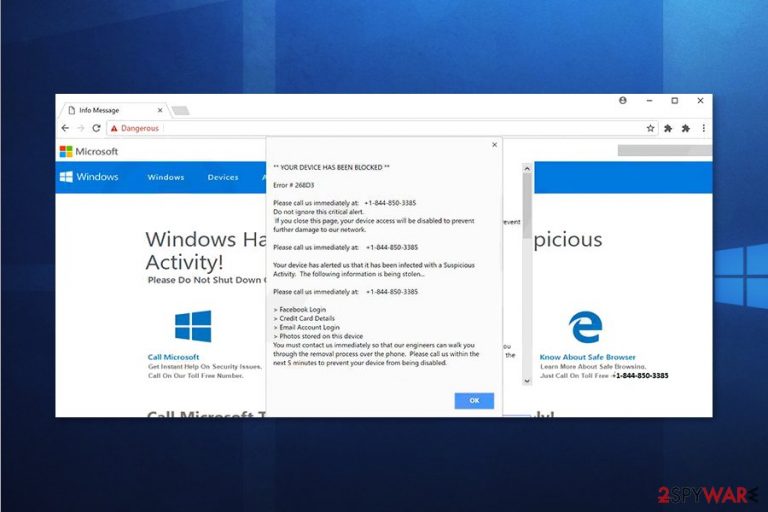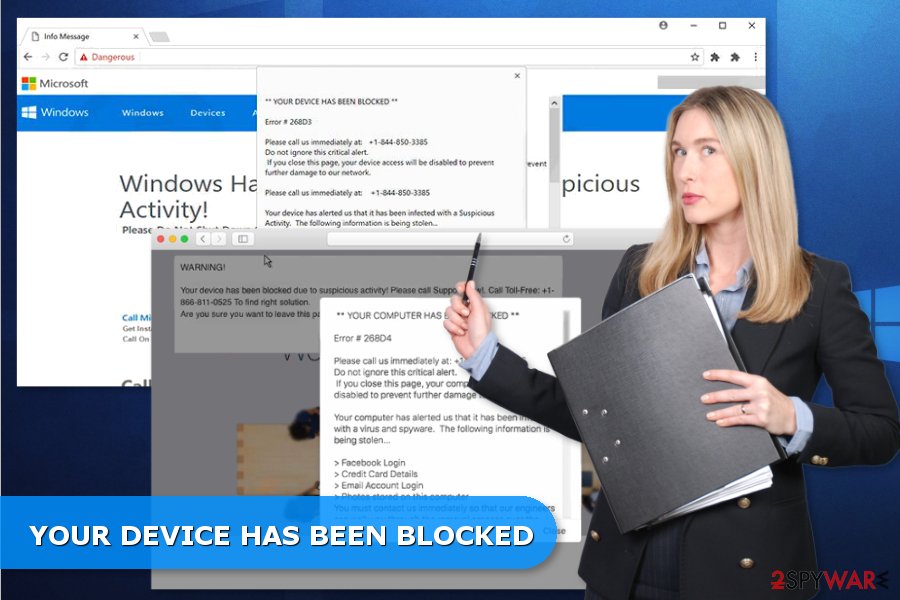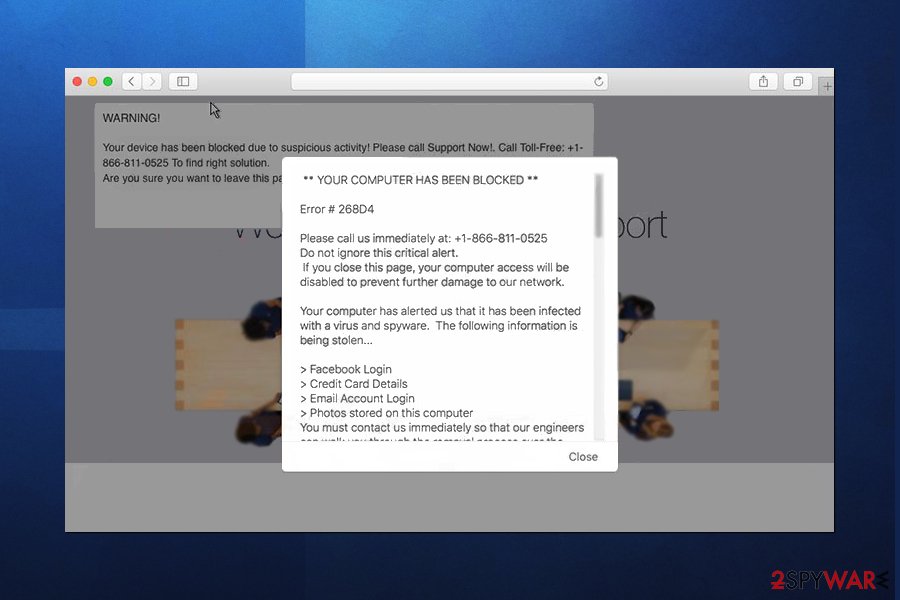YOUR DEVICE HAS BEEN BLOCKED Scam (Free Instructions) - Virus Removal Instructions
YOUR DEVICE HAS BEEN BLOCKED Scam Removal Guide
What is YOUR DEVICE HAS BEEN BLOCKED Scam?
Scammers spread fake YOUR DEVICE HAS BEEN BLOCKED alert

“YOUR DEVICE HAS BEEN BLOCKED” is fake alert that warns about blocked computer due to detected suspicious activities or virus attack. This tech support scam mostly targets Windows computer users. However, a similar version of the hoax has been noticed attacking Mac OS X as well. The purpose of them is to convince users into calling a fake tech support service.
YOUR DEVICE HAS BEEN BLOCKED pop up is delivered by a corrupted website. Usually, these redirects are triggered by an ad-supported application. It might sneak into the computer in a software bundle during installation of freeware or shareware.
When YOUR DEVICE HAS BEEN BLOCKED adware gets inside the system, it redirects users to a misleading website that provides fake information about possible threats and asks to call a provided phone number. Currently, crooks are known for using these numbers:
- +1-844-850-3385;
- +1-866-811-0525;
- +44-800-090-3856.
However, other numbers might be used as well. Users are advised to stay vigilant and do not fall for scammers tricks. Neither Microsoft nor Apple provides phone support service. Thus, chatting with fake support staff might lead to the loss of money or personal information.
If redirects to technical support site do not stop, please obtain FortectIntego, or another anti-malware software to remove YOUR DEVICE HAS BEEN BLOCKED virus from the system. You can wipe out this cyber threat manually as well. The detailed guide is given at the end of the article.

YOUR DEVICE HAS BEEN BLOCKED Microsoft support scam delivers fake error code
As soon as users are redirected to tech support scam website, it delivers a pop-up message that warns about blocked computer due to the critical Error #268D3.[1] However, this error code does not exist. Therefore, there’s no need fixing it.
YOUR DEVICE HAS BEEN BLOCKED
Error #268D3
Please call us immediately at: +1-844-850-3385
Do not ignore this critical alert.
If you close this page, your device access will de disabled to prevent further damage to our network.
Please call us immediately at: +1-844-850-3385
Your device has alerted us that it has been infected with a Suspicious Activity. The following information is being stolen.
Please call us immediately at: +1-844-850-3385
> Facebook logins
> Credit Card details
> Email Account Login
> Photos stored on this device
You must contact us immediately so that our engineers can walk you through the removal process over the phone. Please call us within the next 5 minutes to prevent your device from being disabled.
The urge to call within 5 minutes might prevent inexperienced computer users from thinking critically. However, spontaneous decision to grab a phone and make a call may lead to privacy or computer-related issues.
Mac users are targeted by a similar version of technical support scam

Even though the majority of scams are targeted at Windows computer users, scammers found a new niche and managed to threaten Mac OS X users. It seems that crooks take advantage of a strong belief that Mac devices cannot be infected with cyber threats.[2]
However, users are usually redirected to YOUR DEVICE HAS BEEN BLOCKED Mac scam website by adware program which might be installed without user’s knowledge. However, the fake site delivers a slightly different notification:
** YOUR COMPUTER HAS BEEN BLOCKED **
Error # 268D4
Please call us immediately at: +1-866-811-0525 or +44-800-090-3856
Do not ignore this critical alert.
If you close this page, your computer access will be disabled to prevent further damage to our network.
Your computer has alerted us that it has been infected with a virus and spyware.
However, the provided Mac error code 268D4 is non-existent. Though, if you have seen this alert a couple of times, your device indeed might be infected. But instead of calling the fake support line, you should obtain reputable anti-spyware/anti-malware program and perform YOUR DEVICE HAS BEEN BLOCKED removal.
Adware that is responsible for scam spreads bundled with freeware
Redirects to scam websites usually start after installation of a free program. Many download sites spread software bundles that include lots of additional apps along the primary software. Thus, users should learn to install freeware correctly no matter what operating system they use.
Security experts for LesVirus.fr[3] remind following these installation tips:
- using legit download sources;
- reading Terms of Use, EULA, and Privacy Policy before downloading programs;
- using Advanced/Custom installation instead of Quick/Standard;
- monitoring the process and unmarking the ticks from additional third-party apps.
Getting rid of YOUR DEVICE HAS BEEN BLOCKED virus
The quickest YOUR DEVICE HAS BEEN BLOCKED removal method is system scan with anti-malware or anti-spyware. However, after the system scan browser reset is still needed delete tracking cookies or other invisible components.
However, if you are one of the users who are willing to remove YOUR DEVICE HAS BEEN BLOCKED manually, you can find the guide below the article. However, if you fail and redirects to scam site continues, please opt for the automatic elimination to wipe out components you left.
You may remove virus damage with a help of FortectIntego. SpyHunter 5Combo Cleaner and Malwarebytes are recommended to detect potentially unwanted programs and viruses with all their files and registry entries that are related to them.
Getting rid of YOUR DEVICE HAS BEEN BLOCKED Scam. Follow these steps
Uninstall from Windows
Follow these steps to locate and terminate adware program that is responsible for YOUR DEVICE HAS BEEN BLOCKED scam:
Instructions for Windows 10/8 machines:
- Enter Control Panel into Windows search box and hit Enter or click on the search result.
- Under Programs, select Uninstall a program.

- From the list, find the entry of the suspicious program.
- Right-click on the application and select Uninstall.
- If User Account Control shows up, click Yes.
- Wait till uninstallation process is complete and click OK.

If you are Windows 7/XP user, proceed with the following instructions:
- Click on Windows Start > Control Panel located on the right pane (if you are Windows XP user, click on Add/Remove Programs).
- In Control Panel, select Programs > Uninstall a program.

- Pick the unwanted application by clicking on it once.
- At the top, click Uninstall/Change.
- In the confirmation prompt, pick Yes.
- Click OK once the removal process is finished.
Delete from macOS
This guide helps to get rid of the annoying technical support scam:
Remove items from Applications folder:
- From the menu bar, select Go > Applications.
- In the Applications folder, look for all related entries.
- Click on the app and drag it to Trash (or right-click and pick Move to Trash)

To fully remove an unwanted app, you need to access Application Support, LaunchAgents, and LaunchDaemons folders and delete relevant files:
- Select Go > Go to Folder.
- Enter /Library/Application Support and click Go or press Enter.
- In the Application Support folder, look for any dubious entries and then delete them.
- Now enter /Library/LaunchAgents and /Library/LaunchDaemons folders the same way and terminate all the related .plist files.

Remove from Microsoft Edge
These instructions will help you to wipe out adware-related entries from Microsoft Explorer:
Delete unwanted extensions from MS Edge:
- Select Menu (three horizontal dots at the top-right of the browser window) and pick Extensions.
- From the list, pick the extension and click on the Gear icon.
- Click on Uninstall at the bottom.

Clear cookies and other browser data:
- Click on the Menu (three horizontal dots at the top-right of the browser window) and select Privacy & security.
- Under Clear browsing data, pick Choose what to clear.
- Select everything (apart from passwords, although you might want to include Media licenses as well, if applicable) and click on Clear.

Restore new tab and homepage settings:
- Click the menu icon and choose Settings.
- Then find On startup section.
- Click Disable if you found any suspicious domain.
Reset MS Edge if the above steps did not work:
- Press on Ctrl + Shift + Esc to open Task Manager.
- Click on More details arrow at the bottom of the window.
- Select Details tab.
- Now scroll down and locate every entry with Microsoft Edge name in it. Right-click on each of them and select End Task to stop MS Edge from running.

If this solution failed to help you, you need to use an advanced Edge reset method. Note that you need to backup your data before proceeding.
- Find the following folder on your computer: C:\\Users\\%username%\\AppData\\Local\\Packages\\Microsoft.MicrosoftEdge_8wekyb3d8bbwe.
- Press Ctrl + A on your keyboard to select all folders.
- Right-click on them and pick Delete

- Now right-click on the Start button and pick Windows PowerShell (Admin).
- When the new window opens, copy and paste the following command, and then press Enter:
Get-AppXPackage -AllUsers -Name Microsoft.MicrosoftEdge | Foreach {Add-AppxPackage -DisableDevelopmentMode -Register “$($_.InstallLocation)\\AppXManifest.xml” -Verbose

Instructions for Chromium-based Edge
Delete extensions from MS Edge (Chromium):
- Open Edge and click select Settings > Extensions.
- Delete unwanted extensions by clicking Remove.

Clear cache and site data:
- Click on Menu and go to Settings.
- Select Privacy, search and services.
- Under Clear browsing data, pick Choose what to clear.
- Under Time range, pick All time.
- Select Clear now.

Reset Chromium-based MS Edge:
- Click on Menu and select Settings.
- On the left side, pick Reset settings.
- Select Restore settings to their default values.
- Confirm with Reset.

Remove from Mozilla Firefox (FF)
Check the list of extensions and remove suspicious entries. Additionally, reset Mozilla Firefox to make sure that any invisible entries were not left.
Remove dangerous extensions:
- Open Mozilla Firefox browser and click on the Menu (three horizontal lines at the top-right of the window).
- Select Add-ons.
- In here, select unwanted plugin and click Remove.

Reset the homepage:
- Click three horizontal lines at the top right corner to open the menu.
- Choose Options.
- Under Home options, enter your preferred site that will open every time you newly open the Mozilla Firefox.
Clear cookies and site data:
- Click Menu and pick Settings.
- Go to Privacy & Security section.
- Scroll down to locate Cookies and Site Data.
- Click on Clear Data…
- Select Cookies and Site Data, as well as Cached Web Content and press Clear.

Reset Mozilla Firefox
If clearing the browser as explained above did not help, reset Mozilla Firefox:
- Open Mozilla Firefox browser and click the Menu.
- Go to Help and then choose Troubleshooting Information.

- Under Give Firefox a tune up section, click on Refresh Firefox…
- Once the pop-up shows up, confirm the action by pressing on Refresh Firefox.

Remove from Google Chrome
Reset Google Chrome by following this guide:
Delete malicious extensions from Google Chrome:
- Open Google Chrome, click on the Menu (three vertical dots at the top-right corner) and select More tools > Extensions.
- In the newly opened window, you will see all the installed extensions. Uninstall all the suspicious plugins that might be related to the unwanted program by clicking Remove.

Clear cache and web data from Chrome:
- Click on Menu and pick Settings.
- Under Privacy and security, select Clear browsing data.
- Select Browsing history, Cookies and other site data, as well as Cached images and files.
- Click Clear data.

Change your homepage:
- Click menu and choose Settings.
- Look for a suspicious site in the On startup section.
- Click on Open a specific or set of pages and click on three dots to find the Remove option.
Reset Google Chrome:
If the previous methods did not help you, reset Google Chrome to eliminate all the unwanted components:
- Click on Menu and select Settings.
- In the Settings, scroll down and click Advanced.
- Scroll down and locate Reset and clean up section.
- Now click Restore settings to their original defaults.
- Confirm with Reset settings.

Delete from Safari
You can stop YOUR DEVICE HAS BEEN BLOCKED pop-ups on Chrome by following these instructions:
Remove unwanted extensions from Safari:
- Click Safari > Preferences…
- In the new window, pick Extensions.
- Select the unwanted extension and select Uninstall.

Clear cookies and other website data from Safari:
- Click Safari > Clear History…
- From the drop-down menu under Clear, pick all history.
- Confirm with Clear History.

Reset Safari if the above-mentioned steps did not help you:
- Click Safari > Preferences…
- Go to Advanced tab.
- Tick the Show Develop menu in menu bar.
- From the menu bar, click Develop, and then select Empty Caches.

After uninstalling this potentially unwanted program (PUP) and fixing each of your web browsers, we recommend you to scan your PC system with a reputable anti-spyware. This will help you to get rid of YOUR DEVICE HAS BEEN BLOCKED Scam registry traces and will also identify related parasites or possible malware infections on your computer. For that you can use our top-rated malware remover: FortectIntego, SpyHunter 5Combo Cleaner or Malwarebytes.
How to prevent from getting malware
Stream videos without limitations, no matter where you are
There are multiple parties that could find out almost anything about you by checking your online activity. While this is highly unlikely, advertisers and tech companies are constantly tracking you online. The first step to privacy should be a secure browser that focuses on tracker reduction to a minimum.
Even if you employ a secure browser, you will not be able to access websites that are restricted due to local government laws or other reasons. In other words, you may not be able to stream Disney+ or US-based Netflix in some countries. To bypass these restrictions, you can employ a powerful Private Internet Access VPN, which provides dedicated servers for torrenting and streaming, not slowing you down in the process.
Data backups are important – recover your lost files
Ransomware is one of the biggest threats to personal data. Once it is executed on a machine, it launches a sophisticated encryption algorithm that locks all your files, although it does not destroy them. The most common misconception is that anti-malware software can return files to their previous states. This is not true, however, and data remains locked after the malicious payload is deleted.
While regular data backups are the only secure method to recover your files after a ransomware attack, tools such as Data Recovery Pro can also be effective and restore at least some of your lost data.
- ^ Jake Doe. How to Fix Error # 268D3?. Ugetfix. How to fix a computer.
- ^ Filip Truta. Adware – The Most Prolific Form of Malware on macOS. Macworld. News, tips, and reviews from the Apple experts.
- ^ Les Virus. Les Virus. Latest cyber security and spyware news.
